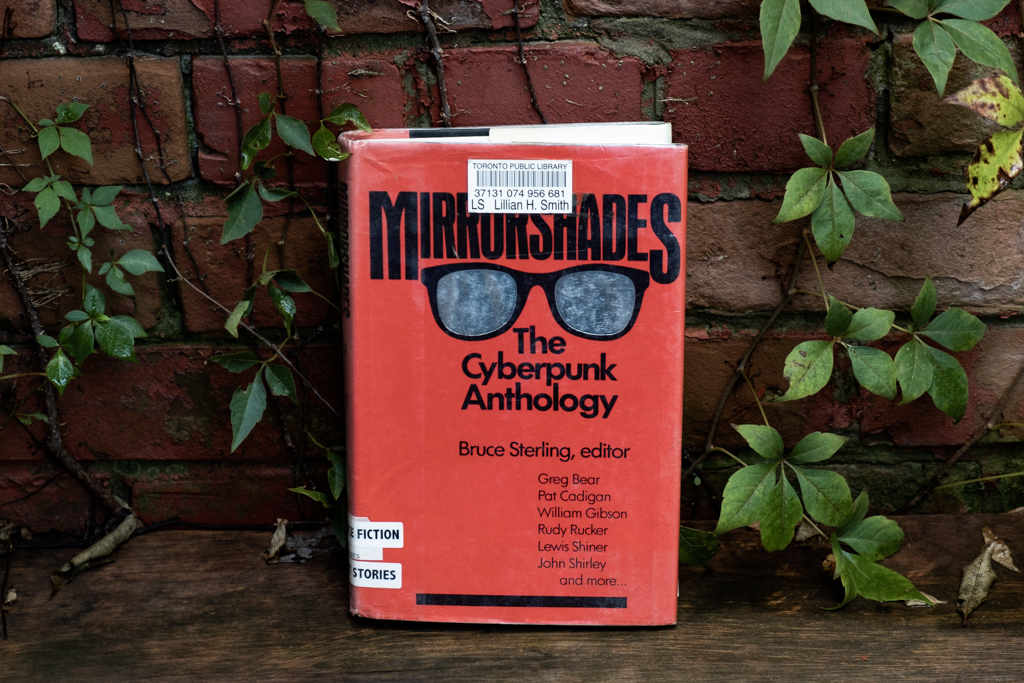
Mirrorshades: The Cyberpunk OG Anthology
Reading the Definitive 1986 Short Story Collection in the 2020s
Discovering Cyberpunk
William Gibson’s Neuromancer, the quintessential cyberpunk novel, was released in 1984, the year I was born, and Mirrorshades, the defining cyberpunk anthology, came out just two years later. Although I would later go on to write three cyberpunk novels of my own, I was literally in diapers when the genre took off and, naturally, had no direct awareness of it at the time.
I was first introduced to the term “cyberpunk” as a young child in the early 90s, through the tabletop RPG Cyberpunk 2020. I was then exposed in early adolescence to a VHS of the soon-to-be classic anime Akira, though I hadn’t yet put it together that it counted as cyberpunk. In high school, I watched Ghost in the Shell, Cowboy Bebop, and other minor cyberpunk classics during all-night, hallucinogen-fuelled anime parties organized by a close friend in his father’s psychotherapy office (a phase of my life that deserves a post, or perhaps a book, of its own…).
I also watched most of the live-action cyberpunk flicks of that era, including Strange Days and Hackers, and that corny marvel of Canadian cinema, Jonny Mnemonic (which surely would have been better if William Gibson’s vision hadn’t been cut to pieces by the distributer at the last minute). There was also The Matrix, of course, which I saw in theatres on opening night, representing the pinnacle of pop cyberpunk cinema to cap off the millennium…
And so it was that my formative years in the 90s were filled with cyberpunk cinema. But my first exposure to cyberpunk literature, wasn’t until the early 2000s, at the age of around 20, when I finally read Neuromancer. This masterpiece of science fiction came to me then, even two decades after its release, as a narrative and conceptual revelation. I’ve since worked my way through most of Gibson’s novels, and have sampled the work of later cyberpunks like Neal Stephenson, Cory Doctorow, and Project Itoh.
My familiarity with the cyberpunk tradition remained patchy, however, until until my debut novel was released and reviewers almost universally classified it as cyberpunk (even though I thought it belonged primarily to the political dystopian tradition exemplified by such novels as We, 1984, and A Handmaid’s Tale). This is when I began to feel that I had to learn more about the early origins of the lineage that I was purportedly contributing to and that was the same age as me.
Reading Mirrorshades, a 1986 anthology of short stories written by a dream team of cyberpunk original gangsters, seemed like the best place to start.
Tracking Down Mirrorshades, The Cyberpunk OG Anthology
Unfortunately, tracking down a copy turned out to be surprisingly difficult; Mirrorshades appears to have been out of print for some time. Until recently, a new copy started at around $150. Going by Bookfinder at time of writing (Sep 2022), the prices appear to have come down slightly, ranging from $100 to nearly $360 without shipping (which is odd because the price of everything else is through the roof…).
Borrowing a copy from the library wasn’t an option for me because the library system in the city in Japan where I live is short on English books and doesn’t carry Mirrorshades. I was tempted to download a pirate copy, which are out there if you know where to look, but I was supposed to be exploring my literary roots, connecting to the minds of the OGs through their words; stealing the text that would have made that possible felt like sacrilege, even if Bruce Sterling, the editor of Mirrorshades, and the other cyberpunk OGs, would have probably given me their blessing.
In the end, I managed to borrow a copy from the Toronto Public Library system, while I visit my family here during the summer/fall of 2022. Here are my thoughts.
***UPDATE Oct 8, 2024: Cyberpunk OG, Rudy Rucker, has made digital editions of the anthology available for free on his homepage.
Mirrorshades: The Preface
Sterling’s legendary preface to the collection serves as a cyberpunk manifesto, in which he traces the movement’s historical influences and trajectory. The mirrored sunglasses of the title, he explains, refer to an image that kept cropping up in early cyberpunk stories. Here is his gloss on this totemic sign:
“By hiding the eyes, mirrorshades prevent the forces of normalcy from realizing that one is crazed and possibly dangerous. They are the symbol of the sun-staring visionary, the biker, the rocker, the policeman, and similar outlaws.”
In light of this quote, the title can be seen as a sort of warning. The word Mirrorshades tells the prospective reader, “beneath these covers awaits the literature of deviance and dissent. Beware!”
As a brief aside, I was personally moved to find a special thanks going out to Japanese translator and editor Yoshio Kobayashi. A rare example of a welcoming figure in the publishing world, he gave me my start in Japanese literary translation after I met him in Tokyo in the early 2010s. Sadly, he was ill for many years after that, and I ended up attending his memorial after his sudden death in 2019. I remembered Yoshio mentioning that he translated the work of Sterling and that they had formed a bond because their kids were around the same age, but I had no idea that he was so central to the early cyberpunk movement.
Yoshio’s English obituary can be found here.
Three Cyberpunk Categories
Given Mirrorshades’ status as the defining cyberpunk collection, I was surprised to discover that the style of the 13 works ranges widely, including several that have little relation to what we now call cyberpunk. To capture this diversity, I would break the stories down into three categories: 1) orthodox cyberpunk, 2) punk adjacent, and 3) proto cyber.
1) Orthodox Cyberpunk
I consider any tale orthodox cyberpunk that matches the catchphrase said to define the genre, “lowlife, high-tech,” or that otherwise exemplifies its common tropes. In the orthodox category, I would place the following six stories, making up nearly half the collection: “Snake Eyes”, “Rock On”, “Solstice”, “Stone Lives”, “Freezone”, and “Red Star, Winter Orbit”.
“Snake Eyes” by Tom Maddox is about a former military pilot suffering side effects from a neural implant. The implant, nicknamed “the snake”, had increased his flight combat reaction time. But now that he has retired, he finds himself suffering from lingering side-effects. Occasionally, the implant disrupts his mental autonomy, making him do strange things like eat cat food. Seeking treatment from a mysterious AI named Aleph, he visits an orbital space station and has a fling with a woman while he continues to fight for control of his own mind.
In terms of style, “Solstice” by James Patrick Kelly is perhaps the most poetic and literary work in the collection. It describes the relationship between an immortal pharmaceutical design tycoon and a young woman cloned from his DNA who he treats as something like a daughter. When she tries to run off with a young talented videographer, the jealous tycoon tries to drug him. The climax finds our antihero protagonist overdosing on designer psychedelics during a solstice festival at Stone Henge.
None of the central characters are standard lowlifes—they are wealthy elites—so one might question the story’s orthodox status. However, since the miserable corporate tycoon has always counted among cyberpunk’s stock character types, I think it nevertheless belongs in this category.
I’m going to admit that I bounced off the longest and most exposition-heavy work in the anthology, “Freezone” by John Shirley. It is described as an “independent excerpt” from a forthcoming series. I read enough to know that it is orthodox CP, but since I didn’t persist to the end, I don’t feel qualified to make any further comment.
If you were to try to write a cyberpunk story according to a formula, one could do much worse than “Stone Lives” by Paul Di Filippo. Set in a future where corporations have parcelled out America into fiefdoms, the narrative centres around a young man violently blinded as a child in the NYC ghetto where he grew up. A mysterious corporate goddess gives him state of the art electronic eyes, restoring his vision, and asks him to pass judgement on her legacy. The twist at the end is well-worth waiting for.
“Red Star, Winter Orbit” is the first collaboration between Sterling and Gibson. (Later they would co-write The Difference Engine, a novel sometimes credited with inaugurating the steampunk genre.) The story revolves around a Russian cosmonaut, the first person to visit Mars. He is caught up in a plot to shut down the space station on which he has lived for decades and from which he is no longer physically capable of leaving. The story is highly redolent of the Cold War era, extrapolating a Soviet-dominated future. Like the “Gernsback Continuum”, which I discuss below, “Red Star, Winter Orbit”is also included in Gibson’s only short story collection, Burning Chrome.
2) Punk Adjacent
Under the category of punk adjacent, I put 3 works: “400 Boys”, “Petra”, and “Mozart in Mirrorshades.”
“400 Boys” features a horde of psychic gangs in a postapocalyptic city who unite to fight off a band of giant, building-stomping babies. Although the paranormal youth bear some resemblance to the test subject children in Akira, a later classic of cyberpunk, I decided “400 Boys” was too cartoony, fantastic, and divorced from hard scientific speculation to fit in the orthodox category. I would describe it as a cross between, The Cabbage Patch Kids, Teenage Mutant Ninja Turtles, and The Uncanny X-Men. In other words, it feels like a fusion of 80s children’s franchises. Very entertaining in a teenage boy sort of way.
The relationship of “Petra” to cyberpunk is marginal at best, but it is perhaps the most original in the collection. In an alternate world, some sort of dream apocalypse has transformed reality into a church where statues of gargoyles and saints come alive and mate secretly with the humans who cower in darkness. The main character is some sort of hideous gargoyle-like creature. When one statue falls in love with a human, the priests try to castrate him and not even the statue of Jesus Christ will save him… You’ve got to be in an irreverent—should I say blasphemous?—mood for this one. I certainly was. It was probably my favourite story of the 13.
“Mozart in Mirrorshades”, a collaboration between Sterling and Shiner, belongs less in the tradition of cyberpunk than in that of satire. The premise is that America has found a way to travel back in time, but if you alter the past in this world, rather than messing with the present, you simply open up a separate continuum. To what noble use does the USA put this technology? Setting up colonies in past eras to exploit them at zero risk to the present, of course.
The narrative takes place in 18th century Italy, where an American colony is harvesting Italian resources and art. In return, the Italians eat up cheap American goods. Mozart, for one, foregoes composing to become a barroom DJ, and Mary Antoinette has been reduced to the sexual plaything of the protagonist. This almost allegorical parody of American Imperialism in the Third World would be at home among the works of Jonathan Swift, Voltaire, Moliere, and Kurt Vonnegut. An underrated gem.
3) Proto Cyber
Under proto cyber, I place three stories.
“The Gernsback Continuum”, Gibson’s first published work, relates the experiences of a photographer whose present is flooded with hallucinations of past visions of the American future. The prose is dense, crammed with often obscure references to Golden Age sci-fi. Judging by the number of academic commentaries on this story, it seems to have the right mix of ambiguity and complexity to appeal to critics and scholars. Sterling introduces the story thus: “A cooly accurate perception of the wrongheaded elements of the past—and a clarion call for a new SF esthetic of the Eighties.”
“Till Human Voices Wake Us” by Lewis Shiner follows a man who spots a mysterious mermaid and later seduces a woman who is her spitting image. I classify it as proto cyberpunk because it is light on futuristic, high tech elements; but for the premise and a few scattered details, it could almost be realism. Moreover, although Shiner refrains from the lyricism and syntactic knots of true Ballardian sentence-craft, I found the the merging of sea imagery and the narrator’s subjectivity all too reminiscent of the work of J.G. Ballard, who Sterling praises in the preface as “an idolized role model to many cyberpunks.” Ballard’s The Drowned World is likewise set in a lagoon and features memorable diving scenes.
“Rock On” by Pat Cadigan, the only female writer in the anthology, is by far the most punk story in the collection and demonstrates the highest mastery of slangy, badass, street language. Not even Gibson quite compares. It is about a woman trying to escape from the business of broadcasting her consciousness to provide the masses with a vicarious experience of being a rockstar.
I think the story counts as proto cyber because its depiction of technology and vision of the future seemed to share more in common with pre-Neuromancer sci-fi than the fully-formed cyberpunk that followed it. I was particularly reminded of A Clockwork Orange by Anthony Burgess, The Girl Who Plugged In by James Tiptree Jr., Coin Locker Babies by Ryu Murakami, and Do Androids Dream of Electric Sheep by Phillip K. Dick.
Miscellany
The one story that isn’t even remotely cyber or punk is “Tales of Houdini” by Rudy Rucker. In fact, it is debatable whether the story—consisting of a series of vignettes in which the historical figure, Harry Houdini, performs a variety of outlandish escapes—counts as SF all. Its inclusion in the anthology is… curious.
Final Words
Mirrorshades lives up to its reputation as the cyberpunk OG anthology—essential reading for all fans of cyberpunk and sci-fi more generally. While the relation of some stories to the cyberpunk aesthetic as we know it today is tenuous, this should not bother those who above all want solid storytelling, as some of the least cyberpunk-esque works are among the finest in the collection. The original gangsters of the genre deliver quality prose and compelling concepts as they elevate it to the next level.
Reading the anthology made me feel proud to have entered this world in 1984, the same year as cyberpunk—not to mention the year foreshadowed by Orwell’s dystopian classic—and to be infusing its tropes with fresh imagination and ideas in the 21st century.
 Eli K.P. William is the author of The Jubilee Cycle trilogy (Skyhorse Publishing), a science fiction trilogy set in a dystopian future Tokyo. He also translates Japanese literature, including the bestselling novel A Man (Crossing) by Keiichiro Hirano, and serves as a writing consultant for a well-known Japanese video game company. His translations, essays, and short stories have appeared in such publications as Granta, The Southern Review, Monkey, and The Malahat Review.
Eli K.P. William is the author of The Jubilee Cycle trilogy (Skyhorse Publishing), a science fiction trilogy set in a dystopian future Tokyo. He also translates Japanese literature, including the bestselling novel A Man (Crossing) by Keiichiro Hirano, and serves as a writing consultant for a well-known Japanese video game company. His translations, essays, and short stories have appeared in such publications as Granta, The Southern Review, Monkey, and The Malahat Review.
More about Eli here.
Follow him on BlueSKy: @elikpwilliam
Or for more essays like this, JOIN ELI’S NEWSLETTER
ALMOST REAL
essays on futurism, philosophy,
speculative fiction, and Japan
by Eli K.P. William
